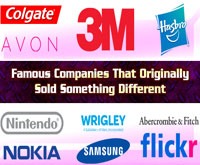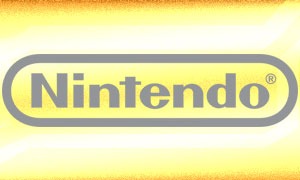Some companies decide on their niche as early as startup. Many started by offering a single product only and then expanding as their business grows. And because profitability is the number one goal, many businesses tend to shift their focus as they eventually discover what they sell or offer best.
These are some of the famous companies that originally sold something different, compared to what they offer today:
 1. Colgate
1. Colgate
“Colgate” is usually used interchangeably with “toothpaste” because well, you obviously know why. The company that now dominates the oral hygiene market originally sold candles, soap, and starch. Founded by William Colgate in 1806, the company had many competitors, so it decided to look for profits elsewhere too. It first offered toothpaste in glass jars in 1873, and by 1896, it started selling the product in a collapsible tube. Today, the brand is also associated with toothbrushes, mouthwashes and dental floss.
 2. Avon
2. Avon
Coined as the world’s premier company for women, Avon was actually found by a man. In 1886, David H. McConnell sold books door-to-door in New York. He was struggling to gain sales, so he offered perfume samples as a gift for women customers who would buy his products. Eventually, the perfume he was giving away became more popular than the books that he was selling, so he started the California Perfume Company. By 1932, the company was renamed Avon, began hiring more female sales representatives and expanded to international markets through the years. By 2013, 88% of the company’s profit came from outside the US.
 3. Wrigley
3. Wrigley
Like Colgate, the Wrigley Company started with selling soap in 1891 and later on, offered baking powder. And like Avon, it also enticed customers by giving freebies, which later on became their main product: chewing gum. After just a few years, it launched its most successful offering, the Juicy Fruit and Spearmint. The company spent a big amount on advertising in the early 1900s, and it successfully paid off. It became one of the most famous gum brands in the world, and as of 2012, the company is valued at $4.4 billion by Forbes.
 4. Nokia
4. Nokia
The Finnish telecom giant and maker of the world’s most durable mobile phone had a long history. Back in 1865, mining engineer Fredrik Idestam built a pulp mill to manufacture paper. After a series of partnerships, mergers, and acquisitions, it produced various products including electricity, cable, rubber, forestry, military equipment and electronics, and eventually, GSM mobile phones in the 1980s.
 5. Hasbro
5. Hasbro
The global toy company behind Monopoly, Transformers and G.I. Joe wasn’t originally kiddie-friendly. In 1923, the Hassenfeld brothers started selling textile remnants, and eventually expanded to offer school supplies. By the 1940s, it created started producing its own nurse and doctor kits, taking a leap to become a toy company. When it released Mr. Potato Head in 1952, the toy became a smash hit. Two years later, the company became a Disney licensee and the rest was history.
 6. 3M
6. 3M
3M products are school and office supplies staples, most especially their post-it notes and Scotch tape. But the company didn’t always produce those, as well as various other products besides consumer goods it currently offers today. Formerly known as the Minnesota Mining and Manufacturing Company, the company originally sold mineral corundum for grinding wheel manufacturers in 1902. When they found that the mineral cannot make a lucrative business, they began selling sandpaper. 3M made history in 1925 as the first company to invent the masking tape, thanks to their lab assistant. Since then, they have produced adhesive tapes, and today, they sell more than 55,000 different products from touch screens and car care to dental products.
 7. Nintendo
7. Nintendo
It’s difficult to picture out Nintendo as a producer of anything other than electronic gaming consoles and video games. In 1889, the firm actually started as a company selling traditional Japanese playing cards. By the 1970s, it branched out its gaming business to electronics and by the next decade, it gained its reputation as a video game manufacturer. Because of its success in the video game industry during the 1990s, the brand was used all over the world to refer to any video game console, until it pushed to preserve its trademark by suggesting the use of the generic term “game console.”
 8. Samsung
8. Samsung
Like a lot of huge multinational companies, Samsung had an entirely different and humble beginning. Literally meaning “three stars,” Samsung first sold fish, homemade noodles and locally-grown groceries in a county in South Korea as a small trading firm. The business prospered, so founder Lee Byung-chull moved its main office to Seoul and started a sugar refinery. As Lee wanted his business to be a leader in a wide range of industries, Samsung branched out into many different areas. In 1970s, it went on to enter the consumer electronics market, eventually being one of the world’s biggest manufacturers of smartphones. In 2014, the company became one of Forbes’ top ten most valuable brands in the world by 2014.
 9. Abercrombie & Fitch
9. Abercrombie & Fitch
Most high school and college students own an Abercrombie and Fitch apparel, but this was not how it was originally envisioned it to be. Founders David Abercrombie and Ezra H. Fitch started the company in 1892 as a seller of sporting goods and as an outfitter. When The Limited acquired them in 1988, A&F became a clothing store of upscale casual wear. The brand is now popular internationally and is most known for their racy ads featuring semi-nude models.
 10. Flickr
10. Flickr
Flickr, the youngest company on this list, was launched in 2004 as a chat room for an online multiplayer game Game Neverending. The chat room’s selling feature is that users can share real-time photos. Eventually, Flickr saw a more feasible project and cancelled the game. In 2005, Yahoo purchased the company, and users of Yahoo Photos were encouraged to migrate to Flickr as the former would be shut down. Flickr has majored in hosting images and videos since then.


 1. Colgate
1. Colgate 2. Avon
2. Avon 3. Wrigley
3. Wrigley 4. Nokia
4. Nokia 5. Hasbro
5. Hasbro 6. 3M
6. 3M 7. Nintendo
7. Nintendo 8. Samsung
8. Samsung 9. Abercrombie & Fitch
9. Abercrombie & Fitch 10. Flickr
10. Flickr